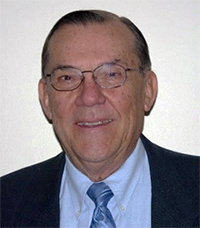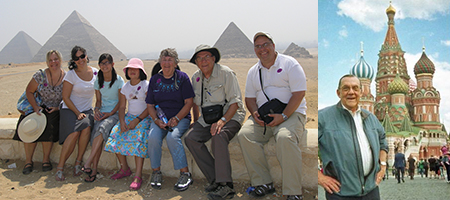In Memoriam: Bruce B. Boecker
1932-2021
by Ray Guilmette and Dunstana Melo



The Health Physics Society (HPS) has lost another charter member and fellow. Dr. Bruce Boecker, BA, MS, PhD, CHP, FHPS, died peacefully on 1 December 2021 in Albuquerque, New Mexico, after a brief but valiant battle with cancer.
Bruce was born (1932) and raised in Naperville, Illinois. He received a BA in physics from Grinnell College, then completed a one-year program in radiological physics at the University of Washington under an Atomic Energy Commission fellowship. During this year while he was developing a career choice, he attended the first meeting of the Health Physics Society in Columbus, Ohio, an event that clearly impacted the young scientist. From there, Bruce joined the Biophysics Division of the US Air Force as a first lieutenant, where he studied the consequences of large-area dispersal of plutonium. After his military service, Bruce studied health physics and radiation biology at the University of Rochester in Newell Stannard's academic program and earned both MS and PhD degrees.
In 1961, Bruce was hired as a staff radiobiologist in the Fission Product Inhalation Program at the Lovelace Foundation for Medical Education and Research in Albuquerque, New Mexico. This organization changed to the Inhalation Toxicology Research Institute (ITRI) in the early 1970s. Bruce's early research at ITRI built on the internal dosimetry studies with plutonium and thorium he had already done during his graduate work at the University of Rochester. He was one of the lead scientists who contributed to the design and conduct of the extensive long-term biological effects studies with fission product radionuclides in experimental animal models, particularly in canines. These pioneering dose-response studies, done mostly using the inhalation exposure route, required significant creativity and invention in aerosol science and engineering as well as internal dosimetry. Bruce was an integral member of that team. In 1974, Bruce was promoted to assistant director of the Radiation Studies Program, a position he held for over 30 years. While continuing his active role as principal investigator for many of the fission product radionuclide studies, he expanded his management responsibilities as ITRI undertook new long-term studies with actinide radionuclides in several animal models. Bruce's skills in managing both the science and scientists in his program cannot be overstated. His personal imprint on the products of the radiation program can be seen throughout most of the 300+ publications. In 1997, he was designated scientist emeritus at the Lovelace Respiratory Research Institute, the successor organization to ITRI.
Being a charter member of the HPS, Bruce recognized even as a graduate student that radiation safety was to be his intellectual beacon, and he followed it for his entire career. His 65+years as a member of the Society are testament to how much he valued his association with the organization and its members. He was also a significant contributor to the Society over the years. As a scientist, Bruce made numerous oral and poster presentations at both annual and midyear meetings, culminating with his Landauer lecture at the 50th annual meeting in Spokane in 2005. He was a diplomate of the American Board of Health Physics (1983) and became emeritus in 1999. He participated in numerous Society committees including Nominating, Program, Publications, and Scientific and Public Issues. Bruce was also elected delegate to five International Radiation Protection Association congresses between 1970 and 1996. From 1985 to 1988, he served as a member of the Board of Directors of the Society. In 1998, Bruce was awarded the Society's Distinguished Scientific Achievement Award in recognition of his important contributions in inhalation toxicology, particularly for inhaled radionuclides, and the development of dose-response relationships for internally deposited radionuclides, i.e., his experimental works at ITRI. He became a fellow of HPS in 1992. Bruce was also active in the Rio Grande Chapter, becoming a charter member in 1962 and serving as president in 1969–1970.
Bruce's impact on radiological health science is also evidenced by his contributions over his career as member or chairman in many important committees, task groups, scientific review groups, and honorary societies. In particular, he was strongly involved in the activities of both the International Commission on Radiological Protection (ICRP) and the National Council on Radiation Protection and Measurements (NCRP). In ICRP, he was a member of the Task Group on Biological Effects of Inhaled Particles (1974–1980), member of Scientific Committee 2 on Doses from Radiation Exposure (1997–2005), and chairman of the Reference Man Task Group of Committee 2 (1997–2005). In NCRP, Bruce was member and chair of several scientific committees as well as member of the Board of Directors, scientific advisor for internal emitters, and technical consultant. He was a member of NCRP Council from 1987 to 1999 and became distinguished emeritus member in 1998 (for more detail on his NCRP career, please visit the NCRP website).
Among the many organizations that benefited from Bruce's participation in their respective committees, task groups, and review groups are the US Energy Research and Development Administration, US Environmental Protection Agency, National Academies of Science, US Department of Energy, Sandia National Laboratory, Oak Ridge Associated Universities, International Agency for Research on Cancer, and Scientific Working Group for Russian Nuclear Workers Health Studies. He was associate scientific editor for Radiation Research Journal (1984–1988) and clinical professor at the University of New Mexico.
Bruce was a man of integrity, righteousness, and loving heart and a faithful Christian. He was a loving and devoted husband to his wife of 60 years, Eleanor (Ellie) Boecker; daughter, Nancy Boecker; son, Brian Boecker; daughter-in-law, Crystal Boecker; and granddaughters, Bayley Boecker, Isabella Boecker, and Ellie Rose Boecker. He was a wise man who had the ability to develop his brilliant scientific career and be a loving and kind husband, father, and grandfather. He knew how to fulfill all the aspects of his professional and personal life with joy, love, and responsibility.
Bruce and Ellie loved to travel. He experienced magical moments with his family exploring the beauty and uniqueness of our world, as you can note from the example images.
Bruce always encouraged and guided the young scientists and friends who had the privilege to meet and work with him. This ability was part of his kindness and was a hallmark of his successful and prodigious career. He had so many friends in this world everywhere and was certainly part of many people's lives. We will always remember him as a unique leader both professionally and personally throughout his lifetime. He established very high standards in an important area—radiation protection.
Bruce dedicated his life to his Savior Jesus Christ and peacefully left to his home in Heaven. We will always miss him and remember his contributions.




